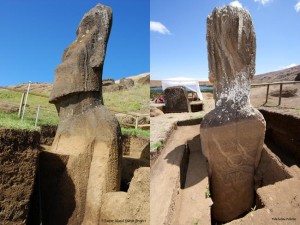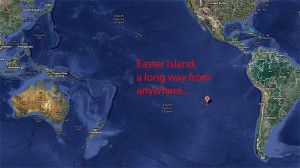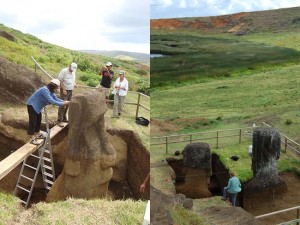 by SIMON CRERAR, News Limited Network
by SIMON CRERAR, News Limited Network
THE giant stone statues scattered around remote Easter Island are even more impressive than they first appear. Hidden from view, the heads are attached to bodies that extend metres underground.
A dig at Rano Raraku, the quarry where Easter Island’s statues were hewn out of rock, is casting new light on a remarkable discovery forgotten for decades.
In 1919 pictures of the first excavations by the Mana Expedition to Easter Island revealed that some statues were full sized. The discovery was confirmed in 1955 by the explorer Thor Heyerdahl when his Norwegian Archaeological Expedition excavated a statue.
Over subsequent decades the discoveries were gradually forgotten, known by archaeologists but not by tourists, who began visiting the island when flights between Santiago and Tahiti, via Easter Island, began in the 1990s.
Today, a team of local archaeologists is working to unlock the secrets of their mysterious island. Led by UCLA archaeologist Jo Anne Van Tilburg, director of the Easter Island Statue Project, they have excavated two seven metre tall, full-size statures, estimated to weigh about 20 tons.
For anyone who has stood next to these huge, imposing heads, or marveled at how a primitive people moved them many kilometres from one side of the island to the other, it’s a remarkable discovery.
 Since 1990, the Easter Island Statue Project (EISP) has been undertaking an archaeological survey on Easter Island, aiming to create a full and complete, island-wide inventory for each statue.
Since 1990, the Easter Island Statue Project (EISP) has been undertaking an archaeological survey on Easter Island, aiming to create a full and complete, island-wide inventory for each statue.
“It is vital to have a good record of the statues,” said the EISP’s director Jo Anne Van Tilburg. “What they look like, where they are found, and how they relate to the sites on which they are found. It is also essential to amass a catalog of the statues as artifacts in order to preserve them for future generations.
Since it was named by the Dutch explorer Jacob Roggeveen on Easter Sunday 1722, the 887 monumental statues of Easter Island have inspired wonder and raised countless questions.
How was the island populated? How were the statues made? How were they moved around the island? And what happened to a society that had resorted to cannibalism by the time Captain James Cook visited in 1774?
In recent decades the anthropologist Jared Diamond and others have held up the eventual decline and fall of Easter Island as a warning of the environmental and societal dangers of over-exploitation.
 Some questions were tackled by the first archaeological expedition to Easter Island, led by Katherine Routledge in 1919. “Unfortunately, the excavations she conducted were very poorly documented, when they were documented at all,” said Van Tilburg. “Therefore, her work was highly flawed and needs to be clarified.”
Some questions were tackled by the first archaeological expedition to Easter Island, led by Katherine Routledge in 1919. “Unfortunately, the excavations she conducted were very poorly documented, when they were documented at all,” said Van Tilburg. “Therefore, her work was highly flawed and needs to be clarified.”
One of the most isolated islands on Earth, Easter Island sits 3,550km west of the South American mainland. It was first settled by Polynesian people who arrived by canoe as part of a great wave of Pacific colonisation.
For decades archaeologists have speculated about how the sculptures were moved and made. How did the islanders move the sculptures? “The most certainly did not ‘walk’ them over challenging terrain for many miles, as has been claimed by some,” said Van Tilburg.
 “More probably statues of different sizes and shapes were moved in a variety of common-sense and practical ways, including especially in horizontal positions.”
“More probably statues of different sizes and shapes were moved in a variety of common-sense and practical ways, including especially in horizontal positions.”
Eventually, the population of Easter Island swelled to around 7000 people, all competing to build statues.
“I don’t think there is any question among today’s researchers that humans were responsible for deforestation on the island, and that deforestation caused significant challenges to the social fabric,” said Van Tilburg. “Nor is there any question that deforestation forced social adaptation, some of which took place in agriculture.
“In fact, the use of the statues changed significantly but, and this is an important caveat, the purpose of the statues remained the same. I think the issue most people have is with the word “collapse.” They find it perforative or somehow blame-filled.”
“I don’t think that is the case at all. There will always be apologists for human behavior we all know is very much a part of the way all of us, no matter what society we are part of, live in the world, historically and even today.”
And what lessons can modern humanity learn from Easter Island? “Society can learn to take the long view and pay attention to the big picture,” says Van Tilburg.
“Rapa Nui society, as the data make clear, was highly conservative but also adaptive when faced with challenges.”
Leave a Reply